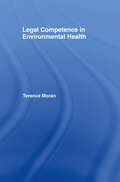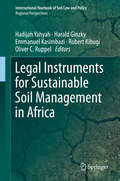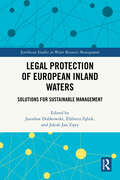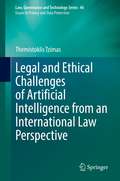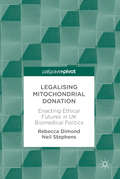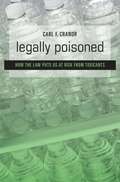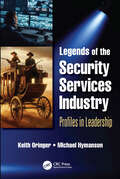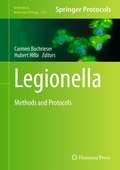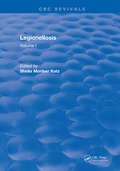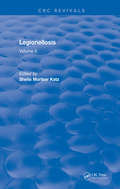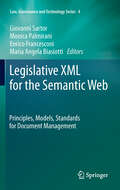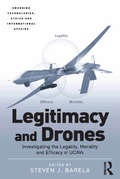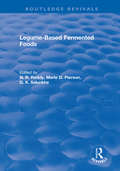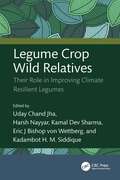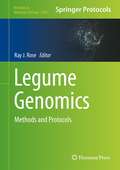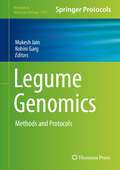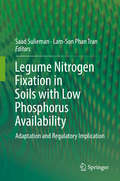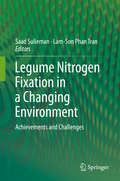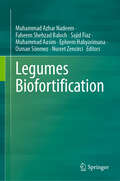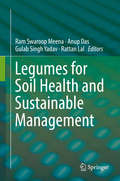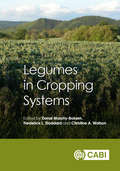- Table View
- List View
Legal Competence in Environmental Health
by Terence MoranLegal Competence in Environmental Health assists the environmental health professional in understanding the operation of English law and navigating through some of its complexities. It covers those aspects of the work which are regulated by legal principles but not found in a single statute.
Legal Instruments for Sustainable Soil Management in Africa (International Yearbook of Soil Law and Policy)
by Harald Ginzky Oliver C. Ruppel Emmanuel Kasimbazi Hadijah Yahyah Robert KibugiThis book presents an important discussion on future options for sustainable soil management in Africa from various perspectives, including national soil protection regulations, the role of tenure rights, the work of relevant international institutions such as the UNCCD and FAO, and regional and international cooperation. This first volume of the new subseries Regional Perspectives to the International Yearbook of Soil Law and Policy includes contributions by African and international experts alike. Given the range of key topics covered, the book offers an indispensable tool for all academics, legislators and policymakers working in this field. The “International Yearbook of Soil Law and Policy – Regional Perspectives” series discusses central questions in law and politics that concern the protection and sustainable management of soil and land in different regions of the world.
Legal Protection of European Inland Waters: Solutions for Sustainable Management (Earthscan Studies in Water Resource Management)
by Jarosław Dobkowski Elżbieta Zębek Jakub Jan ZiętyThis book examines the legal protection and management of inland waters in Europe.With inland waters facing a range of significant threats, including from climate change, pollution, and overexploitation, this volume discusses legal solutions for protecting and managing these inland waters. It presents comparative studies from a range of European countries, including the Czech Republic, Germany, France, Lithuania, Poland, and Spain, with each chapter examining the legal status and legal instruments being implemented in each country, allowing for easy cross-comparison. Topics covered include surface water management and protection, water quality and monitoring, management of hazardous substances, and crisis management. Through these unique comparative studies, the volume highlights legal solutions which can be adopted by other nations and used as models for wider implementation across Europe. In doing so, this book offers important recommendations for changing water law to ensure a water secure future in Europe.This book will be of great interest to students and scholars of water law, water resource management, environmental policy, and environmental conservation.
Legal Regulation of Private Actors in Outer Space: India’s Role
by Malay AdhikariThe book addresses legal issues and challenges in using Space Technology. Especially covered are the provisions of International Space Law and few national space legislations to regulate private actors in outer space. The key chapters covered are history of space regulations, private actors in space, legal issues for such actors, regulating these issues outside India, and the same in India. In concluding chapter, the author has worked out some recommendations.The book would be of immense use to people especially startups in private space industry; students, faculties and scholars of Space Law and Policy, Space Security, Defence and Security Studies.Please note: Taylor & Francis does not sell or distribute the Hardback in India, Pakistan, Nepal, Bhutan, Bangladesh and Sri Lanka
Legal and Ethical Challenges of Artificial Intelligence from an International Law Perspective (Law, Governance and Technology Series #46)
by Themistoklis TzimasThis book focuses on the legal regulation, mainly from an international law perspective, of autonomous artificial intelligence systems, of their creations, as well as of the interaction of human and artificial intelligence. It examines critical questions regarding both the ontology of autonomous AI systems and the legal implications: what constitutes an autonomous AI system and what are its unique characteristics? How do they interact with humans? What would be the implications of combined artificial and human intelligence? It also explores potentially the most important questions: what are the implications of these developments for collective security –from both a state-centered and a human perspective, as well as for legal systems? Why is international law better positioned to make such determinations and to create a universal framework for this new type of legal personality? How can the matrix of obligations and rights of this new legal personality be construed and what would be the repercussions for the international community? In order to address these questions, the book discusses cognitive aspects embedded in the framework of law, offering insights based on both de lege lata and de lege ferenda perspectives.
Legal and Forensic Medicine
by Roy G BeranThis is a comprehensive reference text that examines the current state of Legal Medicine, which encompasses Forensic Medicine, in the 21st century. It examines the scope of both legal and forensic medicine, its application and study and has adopted a wide ranging approach including multinational authorship. It reviews the differences between and similarities of forensic and legal medicine, the need for academic qualification, the applications to many and varied fields including international aid, military medicine, health law and the application of medical knowledge to both criminal law and tort/civil law, sports medicine and law, gender and age related factors from obstetrics through to geriatrics and palliative care as well as cultural differences exploring the Christian/Judeo approach compared with that within Islamic cultures, Buddhism and Hinduism. The book will look at practical applications of legal medicine within various international and intercultural frameworks. This will be a seminal authoritative text in legal and forensic medicine. It has a multi-author and multinational approach which will cross national boundaries. There is a great interest in the development of health law and legal medicine institutes around the world and this text will come in on the ground floor of this burgeoning discipline and will provide the foundation text for many courses, both undergraduate and postgraduate. It will define the place of legal medicine as a specialized discipline.
Legal and Forensic Psychology: What Is It and What It Is Not
by Irena BoškovićThis book seeks to distinguish empirically-based knowledge from widespread misconceptions in the fields of legal and forensic psychology. Across ten chapters, leading scholars contribute different perspectives on their areas of expertise within the fields of legal and forensic psychology, providing a comprehensive overview of the historical context and defining characteristics of these two disciplines. The first section of the book is dedicated to legal psychology, exploring issues such as pseudoscience in lie detection, the use of polygraphs, and the reliability of eyewitness testimony and memory reports in legal settings. The second focuses on forensic psychology, addressing topics such as the relationship between criminal behavior and psychopathology, symptom validity assessment, risk assessment, and the treatment of forensic patients. As such, this vital book will serve as an excellent starting point for those seeking to educate themselves about these disciplines.
Legalising Mitochondrial Donation: Enacting Ethical Futures In Uk Biomedical Politics
by Rebecca Dimond Neil StephensIn 2015 the UK became the first country in the world to legalise mitochondrial donation, a controversial germ line reproductive technology to prevent the transmission of mitochondrial disease. Dimond and Stephens track the intense period of scientific and ethical review, public consultation and parliamentary debates preceeding the decision. They draw on stakeholder accounts and public documents to explore how patients, professionals, institutions and publics mobilised within ‘for’ and ‘against’ clusters, engaging in extensive promissory, emotional, bureaucratic, ethical, embodied and clinical labour to justify competing visions of an ethical future. They describe how this decision is the latest iteration of a UK sociotechnical imaginary in which the further liberalization of human embryo research and use is rendered legitimate and ethical through modes of consultation and permissive but strictly regulated licensing. Overall, this book presents a timely, multi-dimensional, and sociological account of a globally significant landmark in the history of human genetics, and will be relevant to those with an interest in genetics, Science, Technology and Society, the sociology of medicine, reproductive technology, and public policy debate.
Legally Poisoned: How the Law Puts Us at Risk from Toxicants
by Carl F. CranorTake a random walk through your life and you’ll find it is awash in industrial, often toxic, chemicals. Sip water from a plastic bottle and ingest bisphenol A. Prepare dinner in a non-stick frying pan or wear a layer of Gore-Tex only to be exposed to perfluorinated compounds. Hang curtains, clip your baby into a car seat, watch television—all are manufactured with brominated flame-retardants. Cosmetic ingredients, industrial chemicals, pesticides, and other compounds enter our bodies and remain briefly or permanently. Far too many suspected toxic hazards are unleashed every day that affect the development and function of our brain, immune system, reproductive organs, or hormones. But no public health law requires product testing of most chemical compounds before they enter the market. If products are deemed dangerous, toxicants must be forcibly reduced or removed—but only after harm has been done. In this scientifically rigorous legal analysis, Carl Cranor argues that just as pharmaceuticals and pesticides cannot be sold without pre-market testing, other chemical products should be subject to the same safety measures. Cranor shows, in terrifying detail, what risks we run, and that it is entirely possible to design a less dangerous commercial world.
Legends in Gandhian Social Activism: Addressing Environmental Issues By Dissolving Gender And Colonial Barriers (Ecology and Ethics)
by Bidisha MallikThis book is about Madeleine Slade (1892-1982) and Catherine Mary Heilemann (1901-1982), two English associates of Mohandas K. (Mahatma) Gandhi (1869-1948), known in India as Mira Behn and Sarala Behn. The odysseys of these women present a counternarrative to the forces of imperialism, colonialism, capitalism, and globalized development. The book examines their extraordinary journey to India to work with Gandhi and their roles in India’s independence movement, their spiritual strivings, their independent work in the Himalayas, and most importantly, their contribution to the evolution of Gandhian philosophy of socio-economic reconstruction and environmental conservation in the present Indian state of Uttarakhand. The author shows that these women developed ideas and practices that drew from an extensive intellectual terrain that cannot be limited to Gandhi’s work. She delineates directions in which Gandhian thought and experiments in rural development work and visions of a new society evolved through the lives, activism, and written contributions of these two women. Their thought and practice generated a new cultural consciousness on sustainability that had a key influence in environmental debates in India and beyond and were responsible for two of the most important environmental movements of India and the world: the Chipko Movement or the movement against commercial green felling of trees by hugging them, and the protest against the Tehri high dam on the Bhagirathi River. To this day, their teachings and philosophies constitute a useful and significant contribution to the search for and implementation of global ideas of ecological conservation and human development.
Legends of the Security Services Industry: Profiles in Leadership
by Keith Oringer Michael HymansonThe global contract security market now totals over $200 billion, with the number of private security officers exceeding that of public law enforcement officers. But this wasn’t always the case.Legends of the Security Services Industry: Profiles in Leadership presents the unique stories of 15 industry legends, who transformed the industry from early private detective and small night watch companies into large-scale contract security companies. The large-scale companies include, but are not limited to, Pinkerton, Burns International, The Wackenhut Corporation, Guardsmark, Wells Fargo, and U.S. Security Associates; as well as today’s leading security companies, Allied Universal, Securitas, G4S, Prosegur, and GardaWorld.The book begins in the nineteenth century, with early U.S. legendary detectives: Allan Pinkerton and William Burns. Then, the book focuses largely from the mid-twentieth century to the present, where successive generations of legends built large-scale contract security companies which competed with, and then acquired, those formed by the early legends. Part II legends George Wackenhut, Ira Lipman, and Tom Wathen; Part III legends, Charles Schneider, Kenneth W. Oringer, William Whitmore, Jr., and Albert Berger; and Part IV, Scandinavian legends Jørgen Philip-Sørensen, Lars Nørby Johansen, and Thomas Berglund, all developed major security companies. Part V includes current global security leaders Helena Revoredo Gut, Stephan Crétier, and Steve Jones. Part VI reviews the timelines and successful leadership of these legendary leaders, with a look at the future of the industry.The legends’ personal stories contain colorful insight into how they capitalized on the industry’s explosive growth. While each generation of legends faced unique social and competitive landscapes, their personal stories illustrate how they respectively succeeded. Their leadership and management prowess enabled them to achieve great success, as they displayed vision and achieved their goals through grit, determination, hard work, charisma, organizational skills, and calculated risk-taking.Each chapter has been extensively researched and includes firsthand accounts based on interviews with living legends, colleagues, and family of deceased legends. Personal, company and signature event photos add further color to the moving narrative. Their stories are not only highly interesting, but also provide a framework for current leaders, and the next generation of entrepreneurs, on how to build and lead large-scale security service companies. With a Foreword from Robert D. McCrie, PhD, longtime John Jay Professor and editor of the renowned industry publication The Security Letter.
Legionella
by Carmen Buchrieser Hubert HilbiThis Methods in Molecular BiologyTM series book presents methods specifically adapted and developed for the study of distinct features of L. pneumophila. Includes materials lists, reproducible protocols, and notes on troubleshooting and pitfalls.
Legionellosis: Volume I
by KatzLegionellosis is a text in two volumes that presents the modern viewpoint of the agent and the disease. It also chronicles the history of the discovery of Legionella pneumophila. Volume 1 discusses current aspects of the microbe including taxonomy, morphology, biochemistry, and physiology. It also discusses the illness including clinical features, pathology, and therapy. Volume II details the laboratory diagnosis, epidemiology, and pathology. The contributors are amongst the most eminent scientists in their respective fields.
Legionellosis: Volume II
by KatzLegionellosis is a text in two volumes that presents the modern viewpoint of the agent and the disease. It also chronicles the history of the discovery of Legionella pneumophila. Volume 1 discusses current aspects of the microbe including taxonomy, morphology, biochemistry, and physiology. It also discusses the illness including clinical features, pathology, and therapy. Volume II details the laboratory diagnosis, epidemiology, and pathology. The contributors are amongst the most eminent scientists in their respective fields.
Legislative XML for the Semantic Web
by Giovanni Sartor Maria Angela Biasiotti Monica Palmirani Enrico FrancesconiThis volume examines the basic layers of the standard-based creation and usage of legislation. In particular, it addresses the identification of legislative documents, their structure, the basic metadata and legislative changes. Since mature technologies and established practices are already in place for these layers, a standard-based approach is a necessary aspect of the up-to-date management of legislative resources. Starting out with an overview of the context for the use of XML standards in legislation, the book next examines the rationale of standard-based management of legislative documents. It goes on to address such issues as naming, the Akoma-Ntoso document model, the contribution of standard-based document management to handling legislative dynamics, meta-standards and interchange standards. The volume concludes with a discussion of semantic resources and a review on systems and projects.
Legitimacy and Drones: Investigating the Legality, Morality and Efficacy of UCAVs (Emerging Technologies, Ethics and International Affairs)
by Steven J. BarelaUnmanned combat air vehicles, or in common parlance 'drones', have become a prominent instrument in US efforts to counter an objective (and subjective) cross-border terrorist threat with lethal force. As a result, critical questions abound on the legitimacy of their use. In a series of multidisciplinary essays by scholars with an extensive knowledge of international norms, this book explores the question of legitimacy through the conceptual lenses of legality, morality and efficacy, it then closes with the consideration of a policy proposal aimed at incorporating all three indispensable elements. The importance of this inquiry cannot be overstated. Non-state actors fully understand that attacking the much more powerful state requires moving the conflict away from the traditional battlefield where they are at an enormous disadvantage. Those engaging in terrorism seek to goad the ruling government into an overreaction, or abuse of power, to trigger a destabilization via an erosion of its legitimacy. Thus defending the target of legitimacy”in this case, insuring the use of deadly force is constrained by valid limiting principles”represents an essential strategic interest. This book seeks to come to grips with the new reality of drone warfare by exploring if it can be used to preserve, rather than eat away at, legitimacy. After an extensive analysis of the three key parameters in twelve chapters, the practical proposition of establishing a 'Drone Court' is put forward and examined as a way of pursuing the goal of integrating these essential components to defend the citizenry and the legitimacy of the government at the same time.
Legume Based Fermented Foods
by N.R. ReddyThis book provides a comprehensive review of published data on the production of various legume-based fermented foods and critically examines their nutritional quality. The book consists of 14 chapters where the preparation, composition, nutritional quality, and food safety of individual legume-based fermented foods are discussed in detail. This treatise on legume-based fermented foods will be helpful to food scientists and nutritionists in improving the nutritional quality, organoleptic quality, and safety of these foods. It will also serve as an important reference book for scientists and technologists involved in fermented foods research.
Legume Crop Wild Relatives: Their Role in Improving Climate Resilient Legumes
by Harsh Nayyar Uday Chand Jha Kamal Dev Sharma Bishop von Wettberg, Eric J Siddique, Kadambot H. M.Grain legume crops are an important component of global food and nutritional security and help in maintaining agro-ecological systems. They fix atmospheric nitrogen via the root-inhabiting rhizobacteria, thereby minimising the harmful effects caused by the excessive application of synthetic nitrogenous fertilizers in the soil environment. There has been less focus on legume crop wild relatives for harnessing their potential traits and novel gene(s) to incorporate them into the cultivated legumes for developing climate-resilient grain legumes. In this edited book, we will highlight the importance of various potential traits of crop wild relatives, which are yet to be properly harnessed for designing future climate-resilient grain legumes. We also update how advances in molecular genetics and genomics have enabled the underpinning of several candidate genes/genomic regions in various crop wild relatives harbouring adaptive traits that confer climate resilience in grain legumes.Readers will benefit from new information on various crop wild relatives in grain legumes and how these wild relatives could be explored for novel climate resilience genes for developing future climate-resilient legume crops. They will gain an understanding of how genomic advances (genome sequence, pan genomes) have uncovered the novel genomic regions attributed to climate resilience in various grain legumes. Finally, the critical role of these wild relatives in maintaining the lost gene(s) due to the domestication process will be discussed.Comprehensive information on conventional breeding, advanced breeding, and recent advances in genomics covering all the major crop wild relatives of legumes is not available in a single book. Thus, this book will provide readers with the latest updates on various information covering all aspects of wild species of legumes.
Legume Genomics: Methods and Protocols
by Ray J. RoseFeaturing current resources used to discover new legume family genes and to understand genes and their interactions, Legume Genomics: Methods and Protocols provides techniques from expert researchers to study these plants that are so vitally important for food, feed, human nutrition, bioenergy, and industrial purposes. This detailed volume covers genome characterization and analysis, transcriptome analysis and miRNA identification/analysis, forward and reverse genetics, molecular markers, as well as transformation strategies used to investigate gene function and many other topics. Written in the highly successful Methods in Molecular Biology series format, chapters include introductions to their respective topics, lists of the necessary materials and reagents, step-by-step, readily reproducible laboratory protocols, and tips on troubleshooting and avoiding known pitfalls. Authoritative and useful, Legume Genomics: Methods and Protocols aims to serve plant molecular biologists, molecular breeders, plant physiologists and biochemists, developmental biologists, and those interested in plant-microbe interactions.
Legume Genomics: Methods and Protocols (Methods in Molecular Biology #2107)
by Mukesh Jain Rohini GargThis volume looks at the latest techniques used by researchers to help them understand the biology of various cellular processes and agronomic traits, and come up with better strategies to improve legume crops. The chapters in this book cover topics such as legume genomic resources; legume pangenome and organelle genome construction; transcriptome analysis; DNA methylation analysis; double-digest restriction site-associated DNA sequencing; target enrichment sequencing via probe capture; genomic selection and transformation methods; prediction of long non-coding RNAs and secondary structures; genome-wide mining of disease resistance gene analogs; genome editing, and bioactive compound and phosphoproteome analysis. Written in the highly successful Methods in Molecular Biology series format, chapters include introductions to their respective topics, lists of the necessary materials and reagents, step-by-step, readily reproducible laboratory protocols, and tips on troubleshooting and avoiding known pitfalls.Cutting-edge and informative, Legume Genomics: Methods and Protocols is a useful reference for genomicists, molecular breeders, plant molecular biologists, biotechnologists, computational biologists, and developmental biologists. This book is also an excellent resource for any novice and expert researcher involved in various molecular aspects of legume biology or general plant studies.
Legume Nitrogen Fixation in Soils with Low Phosphorus Availability
by Saad Sulieman Lam-Son Phan TranThis thoughtful and provocative book provides a concise, up-to-date presentation of how current and projected future phosphorus scarcity will affect legume growth and their symbiotic nitrogen-fixing capabilities. It is a timely examination of the physiological and molecular responses of nodules to phosphorous deficiency in attempt to identify common principles. Students and researchers in the many disciplines related to crop productivity will find this title an exciting contribution in the area of plant stress physiology. The knowledge in this volume can also aid plant breeders, particularly through new methods of genetic engineering, in developing unique and adaptive cultivars with higher symbiotic efficiency. The awareness of the rapidly rising world population must translate into a parallel increase in agricultural production in order to sustain the growing population both now and in the future. Hence, the demand for food crops to produce proteins and vegetable oil for human consumption is going to increase considerably during the coming years. The essential role of legumes in agriculture is well-recognized, given the abundant levels of proteins and oils found in plants along with their enormous contribution to the sustainability of agricultural systems and human health. The capacity of legumes to fix nitrogen (N2) in partnership with rhizobia provides an input-saving and resource-conserving alternative, thereby reducing the need for chemical fertilizers while enhancing overall crop productivity. The use of N2-fixing legumes to produce plant proteins results in a substantial decrease in the consumption of fossil fuels and therefore also in the agricultural effects to global warming. However, a major constraint to legume production is low soil phosphorus (P) availability, considering that an overwhelming majority of the world's soils are classified as P-deficient. Low-P availability is especially problematic for legumes, since legume nodules responsible for N2 fixation have a high P requirement. Therefore, this book explains how nodule N2 fixation responds to low P availability, which is crucial for improving legume production and maintaining agricultural sustainability in the context of the global P crisis.
Legume Nitrogen Fixation in a Changing Environment
by Saad Sulieman Lam-Son Phan TranThe world population will grow more rapidly during the few coming years. This must be accompanied by a parallel increase in the agricultural production to secure adequate food. Sustainability considerations mandate that alternatives to chemical nitrogen fertilizers must be urgently sought. Biological nitrogen (N2) fixation, a microbiological process which converts atmospheric N2 into a plant-usable form, offers this alternative. Among these renewable sources, N2-fixing legumes offer an economically attractive and ecologically sound means of reducing external inputs and improving internal resources. Environmental factors such as drought, elevated temperature, salinity, soil acidity and rising CO2 are known to dramatically affect the symbiotic process and thus play a part in determining the actual amount of nitrogen fixed by a given legume in the field. Understanding how nodule N2 fixation responds to the environment is crucial for improving legume production and maintaining sustainability in the context of global change. In this thoughtful and provocative new Brief, we provide critical information on how current and projected future changes in the environment will affect legume growth and their symbiotic N2 fixing capabilities. Each section reviews the main drivers of environmental change on the legume performance that include drought, elevated temperature, salinity and rising CO2, and soil acidity. Importantly we discuss the molecular approaches to the analysis of the stress response in legumes and the possible biotechnological strategies to overcome their detrimental effects.
Legumes Biofortification
by Osman Sönmez Ephrem Habyarimana Nusret Zencirci Sajid Fiaz Faheem Shehzad Baloch Muhammad Azhar Nadeem Muhammad AasimSustainable food production is vital to ensure food and nutritional security to growing human population. Recently, there has been a shift in agricultural production system, crop production is not only considering yield as primary interest to produce higher number of calories for reducing hunger, but also more nutrient-rich food to reduce malnutrition or “hidden hunger”. Micronutrient malnutrition is a continuing and serious public health problem in many countries, various Interventions to alleviate this problem have been implemented. Biofortification, the process of breeding nutrients into food crops, provides a comparatively cost effective, sustainable, and long-term means of delivering more micronutrients. Legumes have higher protein content than most plant foods approximately twice than cereals and are rich in the key micronutrients folate, niacin, thiamine, calcium, iron and zinc. This book summarizes the biofortification of legumes. Detailed information through contributed chapters shed light on legumes research relevant to human health, with key topics that include genomic and genetic resources for food security, conventional and modern breeding approaches for improving nutrition, agronomic traits and biotechnological interventions.
Legumes for Soil Health and Sustainable Management
by Rattan Lal Ram Swaroop Meena Anup Das Gulab Singh YadavSustainable management of soils is an important global issue of the 21st century. Feeding roughly 8 billion people with an environmentally sustainable production system is a major challenge, especially considering the fact that 10% of the world’s population at risk of hunger and 25% at risk of malnutrition. Accordingly, the 68th United Nations (UN) general assembly declared 2016 the “International Year of Pulses” to raise awareness and to celebrate the role of pulses in human nutrition and welfare. Likewise, the assembly declared the year 2015 as the “International Year of Soils” to promote awareness of the role of “healthy soils for a healthy life” and the International Union of Soil Science (IUSS) has declared 2015-2024 as the International Decade of Soils. Including legumes in cropping systems is an important toward advancing soil sustainability, food and nutritional security without compromising soil quality or its production potential. Several textbooks and edited volumes are currently available on general soil fertility or on legumes but‚ to date‚ none have been dedicated to the study of “Legumes for Soil Health and Sustainable Management”. This is important aspect, as the soil, the epidermis of the Earth (geoderma)‚ is the major component of the terrestrial biosphere. This book explores the impacts of legumes on soil health and sustainability, structure and functioning of agro-ecosystems, agronomic productivity and food security, BNF, microbial transformation of soil N and P, plant-growth-promoting rhizobacteria, biofertilizers, etc. With the advent of fertilizers, legumes have been sidelined since World War II, which has produced serious consequences for soils and the environment alike. Therefore, legume-based rational cropping/soil management practices must support environmentally and economically sustainable agroecosystems based on (sequential) rotation and intercropping considerations to restore soil health and sustainability. All chapters are amply illustrated with appropriately placed data, tables, figures, and photographs, and supported with extensive and cutting-edge references. The editors have provided a roadmap for the sustainable development of legumes for food and nutritional security and soil sustainability in agricultural systems, offering a unique resource for teachers, researchers, and policymakers, as well as undergraduate and graduate students of soil science, agronomy, ecology, and the environmental sciences.
Legumes in Cropping Systems
by Donal Murphy-Bokern Frederick L. Stoddard Christine A. WatsonBased on contributions from members of the Legumes Future research consortium and complemented by articles from other research teams, this book provides a comprehensive overview of knowledge relevant to developing legume-supported cropping systems in Europe. It reflects the growing interest in using legumes to improve cropping and the current debate over the imbalance in European systems where the low use of legumes has caused concern in the agricultural policy community. This book supports informed debate and decision-making that addresses the associated challenges. Legumes in Cropping Systems presents current knowledge on this subject across 15 coordinated chapters. Each chapter addresses a specific aspect of legume cropping and provides insight into the relevant literature to help support understanding and explore the underlying processes that influence cropping system development. This book includes coverage of: #65533; the role of legumes in cropping systems; #65533; the role of legumes in European protein supplies; #65533; environmental effects of grain and forage legumes; #65533; current status of the major grain and forage legume crops; #65533; economic effects; and #65533; policy development. Written by an international team of expert authors and presented in full-colour throughout, this book is an invaluable resource for researchers in agronomy and crop sciences, agricultural professionals, policy makers, and students.
